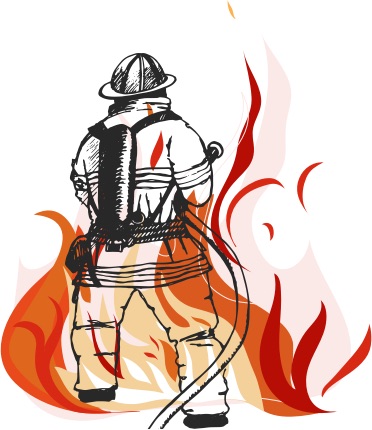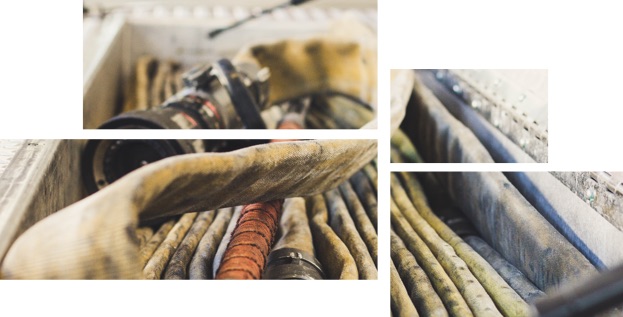
Firefighters and Asbestos Exposure
Firefighters face uniquely extreme asbestos exposure risks, and as a result, they suffer an elevated rate of asbestos-related diseases such as mesothelioma. Many organizations support firefighters with occupational cancer and work to prevent toxic exposure in the future.
Firefighters at Greater Risk of Asbestos Exposure
When people imagine the dangers of firefighting, they often don’t realize cancer is now the No. 1 occupational cause of death for career firefighters. While a soot-covered set of overalls serves as a sign of a proud and brave firefighter, rescue workers should see that visible grit for what it really represents — potentially deadly asbestos contamination.
Face extreme risks of asbestos exposure during rescue operations
2.29 times more likely to develop mesothelioma due to exposure
70% of line-of-duty deaths are caused by cancer in general
Proper training and procedures can prevent occupational cancer
Firefighters learn how to prevent occupational cancer from trade organizations that provide training and informative resources. Other organizations specialize in supporting firefighters stricken with cancer. Firefighters who have suffered toxic exposure because of others’ negligence have legal options for seeking compensation.
We observed about a twofold increase in malignant mesothelioma mortality and incidence compared with the US population.
How Firefighters Are Exposed to Asbestos
During America’s 20th-century building boom, asbestos-containing materials were widely used in public buildings and residential structures — from basements to attics. Most manufacturers phased out the use of the toxic mineral when its link to terrible illnesses, such as lung cancer and mesothelioma, was publicly revealed, but asbestos remains in millions of old buildings across the nation.
Old asbestos-containing materials can release intense concentrations of toxic mineral fibers into the air when buildings burn. Firefighter safety equipment should be issued by fire stations and worn properly during firefighting, then decontaminated after to prevent asbestos exposure. If firefighters are not provided the proper safety equipment, they and their families could be exposed to asbestos and other toxic substances found in ashes and debris.
From the 1930s to the 1970s, manufacturers using asbestos in products mixed asbestos into a range of building materials as a cheap way to make almost anything more durable and fireproof.
Common asbestos-containing building materials included
- Cement floors, sheets and siding
- Roof shingles and sealant
- Vinyl tiles, flooring and wallpaper
- Pipe, duct and attic insulation
- Spray-on coating and fireproofing
- Plastic and millboard for electrical panels
- Insulation for homes, boilers, furnaces and appliances
- Flooring adhesives, wall panels and ceiling tiles
The list of asbestos products goes on. In most circumstances, these materials fall into two categories: Friable materials (such as old pipe insulation) that can release asbestos fibers easily, and nonfriable materials (such as vinyl tiles) that keep asbestos fibers fixed in place.
In a disaster situation, however, all materials are effectively friable.
This is what sets firefighters apart from other tradesmen at risk of asbestos exposure. Most occupational asbestos exposure happens little by little on a regular basis. But for firefighters, exposure may come in the form of a single encounter with asbestos-contaminated smoke or debris.
Some firefighters have also been exposed to asbestos in safety gear. Asbestos was woven into textiles to create fireproof clothing and protective gear for firefighters.
Common asbestos-containing safety gear includes
- Suits
- Gloves
- Boots
- Fire blankets
In the mid-1800s in France, an asbestos-containing face mask was one of the first documented firefighting masks in history. It is not clear whether other firefighting masks contained asbestos in the U.S.
Cancer is the most dangerous and unrecognized threat to the health and safety of our nation’s firefighters.
9/11 First Responders and Asbestos Exposure
When the towers of the World Trade Center fell on 9/11, they released a massive dust cloud of heavy metals, burning plastics and hundreds of tons of pulverized asbestos. In the following months, thousands of firefighters from across the country joined the members of the New York Fire Department in digging through the contaminated rubble, often without being issued respiratory protection.
As a result, first responders exposed to asbestos dust suffer high rates of fatal lung diseases and dozens of different types of cancer. The death toll is set to rise for decades to come because asbestos-related cancers, including mesothelioma and asbestos-related lung cancer, typically do not develop for at least 20 years after exposure.

Asbestos Diseases Firefighters Face
Inhaled asbestos fibers cannot be seen, smelled or tasted and don’t result in immediate symptoms because the fibers cause no immediate chemical reaction in the body. But these mineral fibers can cause illnesses to develop many years later.
In April 2021, data from the North Carolina Insurance Commissioner's Office revealed mesothelioma and prostate cancer are the two most commonly diagnosed cancers reported recently by North Carolina firefighters.
In 2013, the Occupational Health and Safety Administration (OSHA) announced a novel finding from its research study into the medical history of almost 30,000 American firefighters. Compared to the average American, firefighters are more than twice as likely to develop mesothelioma, the signature cancer of asbestos.
According to the OSHA study, firefighters also face elevated rates of many other types of cancer because of toxic chemicals released when a building burns. However, the extremely high incidence of mesothelioma found by the study points to the risky type of occupational asbestos exposure faced by firefighters.
These are some of the conditions related to asbestos exposure:
-
Mesothelioma
Mesothelioma, a result of asbestos exposure, is a rare and aggressive cancer. Cases usually affect the pleural lining, endangering the lungs, heart and chest wall, but can also develop in the peritoneal lining, potentially spreading into abdominal organs. -
Lung Cancer
Lung cancer is most commonly associated with smoking, but asbestos-related lung cancer is responsible for an estimated 6,000 deaths in the U.S. annually. Asbestos-related lung cancer kills more Americans than any other asbestos-related illness. -
Asbestosis
Asbestos in the soft tissue of the lungs can cause scar tissue build-up. While non-cancerous, this scar tissue can cause symptoms similar to mesothelioma, particularly difficulty breathing and chest pain. Asbestosis is progressive and there is no cure for the condition. -
Pleural Plaques and Thickening
Once inside the body, asbestos fibers can migrate into the pleura, which is the tissue lining around the lungs. Irritation from lodged asbestos fibers may lead to development of hard plaques or scarring in the pleural lining, which can make breathing painful.

How Can Firefighters Avoid Asbestos Exposure?
In 2013, the Firefighter Cancer Support Network (FCSN) assembled a panel of experts to create a detailed list of ways firefighters can protect themselves from occupational cancer. By following these key recommendations, firefighters can guard against benign diseases, such as asbestosis and pleural thickening, in addition to asbestos-related cancers.
Keep SCBA on During Overhaul
Always wearing respiratory protection during a firefighting operation is essential. Self-contained breathing apparatus (SCBA) can help protect against inhaling asbestos when opening walls, pulling down ceilings and searching through debris after a fire.
These activities can disturb weakened asbestos materials and stir up toxic dust. Keeping debris wet can minimize the amount of dust in the air.
Decontaminate Gear Thoroughly
Before leaving the site of a fire, firefighters should wash the bulk of the hazardous soot off their tools, personal protective equipment and skin using wet wipes or a hose.
After leaving the site, firefighters should decontaminate PPE according to the National Fire Protection Association standard (NFPA 1851) at the station or send dirty PPE to an appropriate cleaning facility. Firefighters must decontaminate storage areas for PPE as well.
Don’t Bring Home Toxic Materials
Firefighters must keep contaminated PPE and clothes isolated from living and sleeping quarters. To avoid secondhand asbestos exposure, firefighters should shower at the station before returning home to their families.
In particular, volunteer firefighters must change and wash their clothes immediately after a fire, and they should avoid bringing contaminated gear and clothes into their cars and homes.
Request Cancer Prevention Training
Proper training is crucial to avoiding asbestos exposure. If fire departments do not take the initiative in offering training, firefighters must be proactive in requesting it.
The Firefighter Cancer Support Network, International Association of Fire Fighters and other groups offer cancer awareness and prevention courses at fire training academies, fire service conferences and online. These organizations also offer training that instructors can take back with them to their local fire departments.
Stay Safe During Firehouse Maintenance and Training
Unfortunately, asbestos exposure is also a danger to firefighters in nonemergency situations. Firefighters have often encountered asbestos-containing materials when making repairs to old firehouses and preparing abandoned buildings for training exercises.
The intentional burning of a building for fire training is considered a demolition as far as federal asbestos regulations are concerned. That means the building must be inspected and asbestos materials must be properly removed before the fire training.
Get Regular Screening for Occupational Diseases
Even the most thorough precautions will not remove all the environmental hazards firefighters face or reverse the effects of past toxic exposures.
For this reason, firefighters should receive annual medical examinations. They should keep their doctors informed of exposure to any toxic materials. Early detection is essential to the effective treatment of occupational cancers such as mesothelioma.
Firefighter Cancer Decontamination Equipment Grant Program in Florida
In 2020, Florida joined a growing number of states to pass legislation designed to better protect its firefighters from these cancer-causing contaminants.
The Firefighter Cancer Decontamination Equipment Grant Program will provide funding for departments throughout Florida to procure needed supplies, equipment and additional education programs to help reduce exposure. It includes all fire departments, from large municipal entities to small-town volunteer fire stations.
“These firefighters are out there every day, making sure we’re all taken care of,” said state Rep. Elizabeth Fetterhoff, co-sponsor of the bill. “We need to take care of them now.”
The Florida bill complemented legislation in 2019 that extended health benefits to firefighters diagnosed with 21 different types of cancer. More than 30 states have included cancers officially as an occupational disease for firefighters.
The grant will make sure that firefighters aren’t going home with carcinogens because their gear wasn’t properly decontaminated. We were able to pass a bill that is going to help prevent these cancer cases from even occurring.

How Can Firefighters Be Compensated?
Firefighters who develop asbestos-related diseases may file asbestos claims against the manufacturers of the products they were exposed to. These claims include personal injury lawsuits and asbestos trust fund claims. Family members who lose a loved one may file a wrongful death claim.
- For example, in 2019, the surviving family of a U.S. Navy firefighter who died of mesothelioma filed a wrongful death lawsuit against Foster Wheeler Corp. and Buffalo Pumps Inc. The defendants argued that the Navy was responsible for a failure to place warnings on asbestos products, and the court agreed.
- Firefighter lawsuits have also risen because of asbestos exposure in training exercises. In 2010, 49 firefighters sued the city of Everett, Washington, over asbestos exposure that occurred in July 2007. Though at least one fire official knew the city-owned homes they were training in contained asbestos, officials did not warn the firefighters nor direct them to wear SCBA. In 2011, the city settled the lawsuit by agreeing to pay for lifetime medical monitoring and medical costs up to $750,000 for the 49 firefighters.
The link between cancer and firefighting has been well established in the scientific community. The government is starting to catch up by offering workers’ compensation, medical benefits and death benefits, although coverage and criteria vary by state.
At the federal level, the government passed the Zadroga Act in 2010 to create the World Trade Center Health Program. It was created in recognition of the lung conditions caused by 9/11 and other long-term effects. In 2015, the health program’s funding was extended for 75 years to ensure lifetime medical treatment and monitoring for people exposed to the toxic dust of the fallen towers. In 2018, the September 11th Victim Compensation Fund was created, and in 2019, the Never Forget the Heroes: Permanent Authorization of the September 11th Victim Compensation Fund Act was passed.
Today, the program tracks the health of more than 70,000 rescue workers and survivors. All firefighters who participated in the 9/11 recovery operation are encouraged to enroll in the World Trade Center Health Registry.
Previously, New York City first responders were forced to seek compensation by filing a lawsuit in 2003. The basis of the complaint: Government officials had not provided sufficient warning about the dangerous chemicals in the 9/11 dust and debris. In 2010, the city offered a $657 million settlement that would be distributed among about 10,000 claimants based on each person’s severity of exposure and illness.
Penalties for Negligence
Fire departments and government officials have an ethical responsibility to protect firefighters from asbestos. On a practical level, making the effort to prevent toxic exposure is much less costly than dealing with the terrible long-term consequences of occupational cancer.
Legal penalties for failing to prevent asbestos exposure
In August 2018, the Oregon Department of Environmental Quality issued a $14,400 fine to Polk County Fire for conducting firefighter training in an asbestos-contaminated home. The fire department was supposed to hire a licensed inspector to confirm no asbestos was present before training took place.
- In September 2017, the Hawaii Occupational Safety and Health Division fined the Honolulu Fire Department $7,000 for failing to follow proper decontamination procedures after a fire.
- In October 2017, the Occupational Health and Safety Administration levied a $33,000 fine on the city of Gastonia, North Carolina, after firefighters conducted training exercises with asbestos materials in an old department store building. The city of Orlando narrowly avoided fines over a similar situation that occurred in February 2017.
- In November 2017, the city administrator and the fire chief of Marion, South Carolina, were indicted on several charges after evidence was revealed that they allegedly ordered firefighters to remove asbestos materials from a fire department building without proper training or safety equipment.
Resources for Firefighters
Across the United States and around the world, fire service leaders are responding to the rising number of occupational cancer cases involving firefighters. The following are a few examples of trade organizations that can help.


